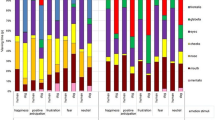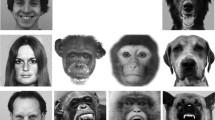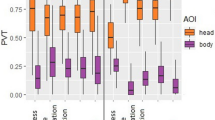Abstract
Our prior visual experience plays a critical role in face perception. We show superior perceptual performance for differentiating conspecific (vs non-conspecific), own-race (vs other-race) and familiar (vs unfamiliar) faces. However, it remains unclear whether our experience with faces of other species would influence our gaze allocation for extracting salient facial information. In this eye-tracking study, we asked both dog owners and non-owners to judge the approachability of human, monkey and dog faces, and systematically compared their behavioural performance and gaze pattern associated with the task. Compared to non-owners, dog owners assessed dog faces with shorter time and fewer fixations, but gave higher approachability ratings. The gaze allocation within local facial features was also modulated by the ownership. The averaged proportion of the fixations and viewing time directed at the dog mouth region were significantly less for the dog owners, and more experienced dog owners tended to look more at the dog eyes, suggesting the adoption of a prior experience-based viewing behaviour for assessing dog approachability. No differences in behavioural performance and gaze pattern were observed between dog owners and non-owners when judging human and monkey faces, implying that the dog owner’s experience-based gaze strategy for viewing dog faces was not transferable across faces of other species.




Similar content being viewed by others
References
Bar, M., & Biederman, I. (1998). Subliminal visual priming. Psychological Science, 9, 464–469.
Barton, J. J. S., Radcliffe, N., Cherkasova, M. V., Edelman, J., & Intriligator, J. M. (2006). Information processing during face recognition: the effects of familiarity, inversion, and morphing on scanning fixations. Perception, 35, 1089–1105.
Borghi, A. M., & Cimatti, F. (2010). Embodied cognition and beyond: acting and sensing the body. Neuropsychologia, 48, 763–773.
Bruce, V. (1982). Changing faces: visual and non-visual coding processes in face recognition. The British Journal of Psychology, 73, 105–116.
Buchan, J. N., Pare, M., & Munhall, K. G. (2000). Spatial statistics of gaze fixations during dynamic face processing. Social Neuroscience, 2, 1–13.
Carmel, D., & Bentin, S. (2002). Domain specificity versus expertise: factors influencing distinct processing of faces. Cognition, 83, 1–29.
Crespi, S., Robino, C., Silva, O., & de’Sperati, C. (2012). Spotting expertise in the eyes: Billiards knowledge as revealed by gaze shifts in a dynamic visual prediction task. Journal of Vision, 12(11), 30.
Dehon, H., & Brédart, S. (2001). An other-race effect in age estimation from faces. Perception, 30, 1107–1113.
Donovan, T., & Manning, D. J. (2007). The radiology task: bayesian theory and perception. British Journal of Radiology, 80, 389–391.
Guo, K. (2012). Holistic gaze strategy to categorize facial expression of varying intensities. PLoS ONE, 7(8), e42585.
Guo, K. (2013). Size-invariant facial expression categorization and associated gaze allocation within social interaction space. Perception, 42, 1027–1042.
Guo, K., Mahmoodi, S., Robertson, R. G., & Young, M. P. (2006). Longer fixation duration while viewing face images. Experimental Brain Research, 171, 91–98.
Guo, K., Tunnicliffe, D., & Roebuck, H. (2010). Human spontaneous gaze patterns in viewing of faces of different species. Perception, 39, 533–542.
Guo, K., & Shaw, H. (2015). Face in profile view reduces perceived facial expression intensity: an eye-tracking study. Acta Psychologica, 155, 19–28.
Heisz, J. J., & Shore, D. I. (2008). More efficient scanning for familiar faces. Journal of Vision, 8, 1–10.
Hills, P. J., & Lewis, M. B. (2011). Reducing the own-race bias in face recognition by attentional shift using fixation crosses preceding the lower half of a face. Visual Cognition, 19, 313–339.
Humphrey, K., & Underwood, G. (2009). Domain knowledge moderates the influence of visual saliency in scene recognition. British Journal of Psychology, 100, 377–398.
Kestenbaum, R. (1992). Feeling happy versus feeling good: the processing of discrete and global categories of emotional expressions by children and adults. Developmental Psychology, 28, 1132–1142.
Kundel, H. L., Nodine, C. F., Krupinski, E. A., & Mello-Thomas, C. (2008). Using gaze-tracking data and mixture distribution analysis to support a holistic model for the detection of cancers on mammograms. Academic Radiology, 15, 881–886.
Levin, D. T. (2000). Race as a visual feature: using visual search and perceptual discrimination tasks to understand face categories and the cross-race recognition deficit. Journal of Experimental Psychology: General, 129, 559–574.
Malcolm, G. L., Lanyon, L. J., Fugard, A. J. B., & Barton, J. J. S. (2008). Scan patterns during the processing of facial expression versus identity: an exploration of task-driven and stimulus-driven effects. Journal of Vision, 8(8), 2.
Matsumoto, H., Terao, Y., Yugeta, A., Fukuda, H., Emoto, M., et al. (2011). Where do neurologists look when viewing brain ct images? an eye-tracking study involving stroke cases. PLoS ONE, 6(12), e28928.
McKone, E., Kanwisher, N., & Duchaine, B. C. (2006). Can generic expertise explain special processing for faces? Trends in Cognitive Sciences, 11, 8–15.
Meissner, C. A., & Brigham, J. C. (2001). Thirty years of investigating the own-race bias in memory for faces: a meta-analytic review. Psychology, Public Policy, and Law, 7, 3–35.
Nabatilan, L. B., Aghazadeh, F., Nimbarte, A. D., Harvey, C. C., & Chowdhury, S. K. (2012). Effect of driving experience on visual behaviour and driving performance under different driving conditions. Cognition, Technology & Work, 14, 355–363.
Nodine, C. F., Kundel, H. L., Lauver, S. C., & Toto, L. C. (1996). Nature of expertise in searching mammograms for breast masses. Academic Radiology, 3, 1000–1006.
O’Toole, A. J., Deffenbacher, K. A., Valentin, D., & Abdi, H. (1994). Structural aspects of face recognition and the other-race effect. Memory and Cognition, 22, 208–224.
Pascalis, O., & Bachevalier, J. (1998). Face recognition in primates: a cross species study. Behavioural Processes, 43, 87–96.
Pihko, E., Virtanen, A., Saarinen, V. M., Pannasch, S., Hirvenkari, L., Tossavainen, T., … Hari, R. (2011). Experiencing art: the influence of expertise and painting abstraction level. Frontiers in Human Neuroscience, 5, 94. doi:10.3389/fnhum.2011.00094.
Reingold, E. M., Charness, N., Pomplun, M., & Stampe, D. M. (2001). Visual span in expert chess players: evidence from eye movements. Psychological Science, 12, 48–55.
Rousselet, G. A., Mace, M. J. M., & Fabre-Thorpe, M. (2004). Animal and human faces in natural scenes: how specific to human faces is the N170 ERP component? Journal of Vision, 4, 13–21.
Schyns, P. G., Petro, L. S., & Smith, M. L. (2007). Dynamics of visual information integration in the brain for categorizing facial expressions. Current Biology, 17, 1580–1585.
Underwood, G. (1998). Eye guidance in reading and scene perception (1st ed.). Amsterdam: Elsevier.
Valentine, T. (1991). A unified account of the effects of distinctiveness, inversion, and race in face recognition. Quarterly Journal of Experimental Psychology, 43, 161–204.
Valentine, T., & Endo, M. (1992). Towards an exemplar model of face processing: the effects of race and distinctiveness. The Quarterly Journal of Experimental Psychology Section A: Human Experimental Psychology, 44, 671–703.
van Belle, G., Ramon, M., Lefèvre, P., & Rossion, B. (2010). Fixation patterns during recognition of personally familiar and unfamiliar faces. Frontiers in Psychology, 1, 20. doi:10.3389/fpsyg.2010.00020.
Vernon, R. J. W., Sutherland, C. A. M., Young, A. W., & Hartley, T. (2014). Modeling first impressions from highly variable facial images. Proceedings of the National Academy of Sciences of the United States of America, 111, 3353–3361.
Vogt, S., & Magnussen, S. (2007). Expertise in pictorial perception: eye-movement patterns and visual memory in artists and laymen. Perception, 36, 91–100.
Wan, M., Bolger, N., & Champagne, F. A. (2012). Human perception of fear in dogs varies according to experience with dogs. PLoS ONE, 7(12), e51775.
Waters, A. J., Underwood, G., & Findlay, J. M. (1997). Studying expertise in music reading: use of a pattern-matching paradigm. Perception and Psychophysics, 59, 477–488.
Willis, M. L., Palermo, R., & Burke, D. (2011). Judging approachability on the face of it: the influence of face and body expressions on the perception of approachability. Emotion, 11, 514–523.
Wood, G., Batt, J., Appelboam, A., Harris, A., & Wilson, M. R. (2014). Exploring the impact of expertise, clinical history, and visual search on electrocardiogram interpretation. Medical Decision Making, 34, 75–83.
Young, A. W., Hellawell, D., & Hay, D. C. (1987). Configurational information in face perception. Perception, 16, 747–759.
Zangemeister, W. H., Sherman, K., & Stark, L. (1995). Evidence for a global scanpath strategy in viewing abstract compared with realistic images. Neuropsychologia, 33, 1009–1025.
Author information
Authors and Affiliations
Corresponding author
Rights and permissions
About this article
Cite this article
Gavin, C.J., Houghton, S. & Guo, K. Dog owners show experience-based viewing behaviour in judging dog face approachability. Psychological Research 81, 75–82 (2017). https://doi.org/10.1007/s00426-015-0718-1
Received:
Accepted:
Published:
Issue Date:
DOI: https://doi.org/10.1007/s00426-015-0718-1




